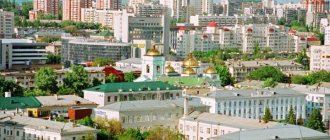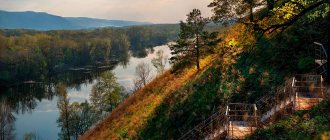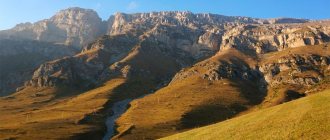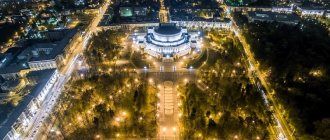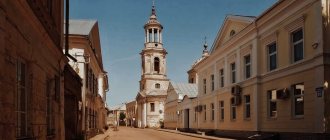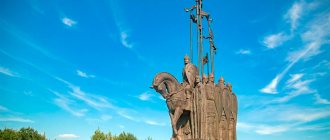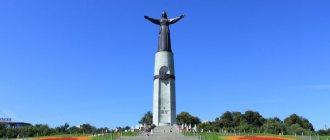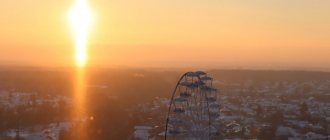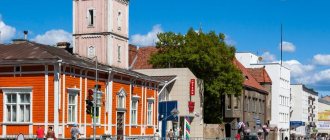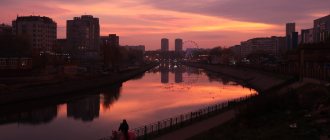- Essays
- Cities
- Belgorod
The date of the founding of Belgorod has not yet been clarified by historians, but now this city is the spiritual center of Russia.
Belgorod is considered a clean city with a temperate climate, pests, the air of which is absorbed by numerous greenery.
The suburban part of the region is suitable for growing agricultural products, and all Belgorod residents feed on groundwater. You can also buy clean water in 5-liter bottles or stock up in the Monastery Forest or other springs.
Belgorod is divided into two parts - Eastern and Western, despite these sections, there are other names for the districts: Silver Horseshoe, Vladimirsky, Novy-2 and others, where high-rise buildings rise.
Due to new buildings, the city's infrastructure is being updated day by day, replacing sprouting, rural corn with neighborhoods with shops and schools.
In the central part of the city, Cathedral Square is laid with beautiful tiles that characterize the coats of arms of the districts. During flowering, street flower beds and pots around the city bloom with different colors of flowers. Both this climate and landscape do not leave the city until the first cold weather sets in. Crossing two bridges, we get to Kharkov Mountain in the southern part of the city.
People feast on local bakery and confectionery products produced at the Kolosok plant, and dairy products from the Belgorod plant. In addition, the city is replete with department stores, supermarkets and trading houses, where you can find anything you need for everyday life. Universal markets, market squares and market stalls present consumers with goods from A to Z. In office centers, skilled entrepreneurs build their businesses and negotiate about this and that, decorating the city with business, including many hotels and innovation centers adjacent to casinos and beautiful palace.
From the architecture of the 19th century you can look at the Holy Trinity Cathedral and the glass dome near the Chapel of Joseph. The Philharmonic is open for musicians, to admire the paintings in the museum, and the troupe in the theater.
The Wedding Palace invites young people to the 24-hour Art Club, to party with a DJ and musicians, and, of course, to enjoy an incendiary program. The city is full of restaurants, banquet facilities and cozy cafes, where you can have a snack while relaxing on the boulevard.
You can simply walk around the city and admire the street sculptures and monuments that capture various episodes of the city's inhabitants.
For lovers of nature recreation and barbecue, they will be greeted by a color-musical fountain near the embankment and an evening beach with its shiny and yellow sand.
Sights of Belgorod in one day
"Battle of Kursk. Belgorod direction"
"Battle of Kursk. Belgorod direction"
The city's most famous landmark. The diorama museum opened its doors to visitors in 1987.
The exhibition is dedicated to the legendary tank battle near the village of Prokhorovka. It is worth paying attention to the diorama “Arc of Fire” - depicting the Battle of Kursk. This huge work of art consists of a painting in the background and a model of the area of 500 square meters. m. The museum will attract the attention of connoisseurs of military history.
Address: Popova street, 2, Belgorod
Opening hours: daily from 9:00 to 19:00; Monday - closed
Entrance: for adults from 250 rub.
Museum of History and Local Lore
Museum of History and Local Lore
The oldest museum in Belgorod opened in 1924. All exhibitions tell about the history of the region. There is an extensive collection of archaeological finds - weapons, jewelry, tools. Also interesting are the departments of numismatics, folk costumes, and household items.
You can get acquainted with the collections of insects, birds, animals and plants of the Belgorod region. This classic local history museum will appeal to cultural lovers.
Address: Popova street, 2a, Belgorod
Opening hours: daily from 10:00 to 19:00
Entrance: for adults - 160 rubles, children under 16 years old - free
Smolensky Cathedral
Smolensky Cathedral
The building was built at the beginning of the 18th century. But little remains of the original structure. The temple was closed after the 1917 revolution, then it was used as a warehouse. The cathedral suffered especially hard during the Second World War during artillery shelling.
In the 80s of the 20th century, a thorough restoration was carried out. And in 1991, services began to be held in the cathedral again. The temple is interesting as a religious building with typical architecture of the 18th century of Sloboda Ukraine.
Address: Civil Avenue, 50 A, Belgorod
Opening hours: daily from 7:00 to 20:00
Official website: https://smsobor.rf/
Sundial
Sundial
The Sundial art object was installed in front of the Central Market in 2008. On the square there is a huge dial with columns and divisions. A shadow from a bronze arrow falls on the granite circle. The watch shows the time quite accurately, within 10 minutes. You can admire the art object at night when the lighting is on.
The attraction is always crowded. Couples in love make dates here, and city guests love to take selfies with the clock in the background.
Address: Narodny Boulevard, Belgorod
Assumption-Nicholas Cathedral
Assumption-Nicholas Cathedral
The oldest Orthodox building in Belgorod. Founded by Peter 1 in 1703. This is a quadrangular building with five domes and a hipped bell tower. In the early 30s of the 20th century, the cathedral was closed, and its premises were given to a bakery.
After 50 years (1986), the building was taken under protection as an architectural monument. Soon its restoration began. And since 2005, the cathedral has been reopened to parishioners. Both local believers and visiting connoisseurs of ancient architecture come here.
Address: Pushkin street, 19a, Belgorod
Opening hours: daily from 7:00 to 19:00
Free admission
Official website: https://bel1-14.cerkov.ru/
Transfiguration Cathedral
(Preobrazhenskaya st. 63-B)
The first mention of the Transfiguration Church of Belgorod can be found in the earliest source on the history of Belgorod - the Scribe books of V.A. Kerekreisky, dated 1626: “in Streletskaya Sloboda, the Church of the Transfiguration of the Lord and the chapel of Dmitry Solunsky” and according to some sources even earlier. The exact location of this church is difficult to determine. We can only say with complete certainty that it was located in Ostrog, on the “Nogai side,” that is, on the territory of the modern Old Town.
Link title: work is nonsense, relax, friends
Transfiguration Cathedral (Preobrazhenskaya St. 63-B)
The Church of the Transfiguration existed even after Belgorod was moved to the right bank of the Seversky Donets. In later sources - church books of the Belgorod Nikolaevsky Monastery, both the Transfiguration Church itself and some of its clergy are mentioned. In 1813, a two-story church was opened and consecrated, built, as is commonly believed, in honor of the victory of Russian troops over Napoleon (in the style of Russian classicism according to the projector of the architect E.A. Vasiliev). For the first two decades of its existence, it was called the Transfiguration-Ilinsko-Alexander Nevsky Church.
In August 1925, the ancient Trinity Cathedral was closed and the Transfiguration Church received the status of a cathedral. In order to save one of the main shrines of the land of Belgorod - the icon of Nicholas the Ratnoy - from destruction, believers secretly took it from the Trinity Cathedral and transferred it to the Transfiguration Cathedral.
Local authorities did not dare to close the main temple of the city. The Transfiguration Cathedral operated during the years of Soviet power for almost half a century. It preached the word of God during the difficult years of persecution of the church, and during the Great Patriotic War, and in the post-war hard times. The cathedral was closed in 1962. After a decade-long renovation and redevelopment that significantly changed its interior, according to tradition at that time, the Transfiguration Cathedral was transferred “at the request of the workers” to the regional museum of local lore.
The refurbishment of the temple was not as easy as it seemed. From the very beginning, it became clear that, despite the impressive size, the usable area of the cathedral was insufficient, so the original idea of creating a planetarium in addition to the museum was abandoned. The museum was opened on October 22, 1973. Its sixteen halls, covering an area of 1,116 square meters on two floors, housed about four and a half thousand exhibits and historical documents from ancient times to the early 1970s. At the entrance to the Orthodox church, which became a museum, a stone statue of a pagan “woman” and a cannon from the time of the Battle of Poltava were installed. On the northern side of the temple, a T-34 tank and a cannon from the Great Patriotic War were placed in an “eternal” parking lot, and on the eastern side, along Popov Street, a tractor from the 1930s and a huge block of ore.
For seventeen years, the Transfiguration Cathedral housed a museum. It is unlikely that any of the Belgorod residents in those years could have imagined that time would pass and the cathedral would be returned to the believers again. After all, when in 1973 the regional museum of local history was solemnly opened in the cathedral building, everyone believed that it was moving here forever. But in the second half of the 1980s, attitudes towards the church began to change. On August 19, 1990, on the patronal feast day, a divine service was held at the walls of the temple. Since September 1990, the cathedral has been gradually transferred to the Church. By September 1991 The temple was completely liberated in connection with the Second Discovery of the relics of St. Joasaph, Bishop of Belgorod. On September 17, 1991, the relics of St. Joasaph were solemnly transferred to the Transfiguration Cathedral, with the participation of His Holiness Patriarch Alexy II of Moscow and All Rus', with a procession of the cross. So Saint Joasaph, as it were, re-sanctified Belgorod with his presence - the place of his last exploits. Italic style
So, blah blah blah and so on, Sasha walked along the highway and sucked on a dryer... for clothes! HA HA HA==Main Cathedral of the city==
Transfiguration Cathedral
The Transfiguration Cathedral is the main temple of the Belgorod and Stary Oskol diocese, storing the incorruptible relics of St. Joasaph and the miraculous icon of Nicholas the Ratnoy - the most revered shrines of Belgorod. It is located on Preobrazhenskaya Street. The history of the Transfiguration Cathedral begins in 1626, according to the mention in the Scribe books. The first Transfiguration Church was located on the left bank of the Seversky Donets. Then it was moved to the right bank of the river. At the beginning of the 19th century, the unification of the wooden Preobrazhensky and stone Ilyinsky churches took place under the Archbishop of Belgorod and Kursk Feoktist (Mochulsky).
The architect of the Transfiguration Cathedral was Kharkov resident Evgeniy Alekseevich Vasiliev. But many Belgorod residents also contributed, contributing to the construction. In 1813, a new two-story church was opened and consecrated. Built in honor of the victory of Russian troops over Napoleon, it was called the Preobrazhensko-Ilinsko-Alexander Nevsky Church for 20 years. The reason for this was the presence of three altars: the Transfiguration of the Lord and the Prophet Elijah, left over from the old churches, and a new one in honor of the holy prince Alexander Nevsky. The abolition of the last throne entailed the creation of three new ones: in honor of the myrrh-bearing women, the Epiphany of the Lord and the sign of the Mother of God.
The October Revolution had an unfavorable effect on the Church of the Transfiguration. In 1922, church valuables were removed from it, but at the same time the icon of Nicholas the Ratnoy was moved here. On June 16, 1934, by decision of the city authorities, the church was closed, and the place was used as a warehouse for storing grain.
In October 1973, the cathedral housed a local history museum.
In 1994, the cathedral acquired the relics of Joasaph.
After a thorough renovation, the Transfiguration Cathedral received a rebirth and became even more beautiful than before. Monument to Saint Joasaph (Pushkin St.)
50°35.796′ N.
w. 36°34.642′ E. e. Expression error: unidentified punctuation symbol "," , Expression error: unidentified punctuation symbol "," &spn=0.3,0.3&t=k&hl=ru (G) Monument to St. Joasaph
(Pushkin St.)
Saint Joasaph was one of the most prominent figures in the history of the Russian Orthodox Church in our region. His life and work dates back to the 18th century. The name of Joasaph is associated with the most revered shrines today by the Belgorod and Stary Oskol Diocese - the icon of the Most Holy Theotokos “The Sign” and the relics of the Saint himself, canonized by the decision of the Holy Synod back in 1911.
The sculpture, made in the workshop of the famous Belgorod sculptor Anatoly Shishkov, was originally installed on Litvinov Street near the Theological Seminary. This happened on November 2, 2001. Subsequently, the monument to St. Joasaph, Bishop of Belgorod the Wonderworker, was moved from the theological seminary to the site of the former Rodina cinema, where there is now a landscaped public garden. The location for the monument was not chosen by chance, also because the St. Nicholas Assumption Cathedral is located nearby and this place is considered historical.
And in the same place, near the seminary, there is a monument to Metropolitan Macarius (Bulgakov), the famous historian of the Russian Orthodox Church, a graduate of the seminary.
Sights in the vicinity of Belgorod
Museum-Reserve "Prokhorovskoye Field"
Museum-Reserve "Prokhorovskoye Field"
Began work in 1995. The historical reserve covers the field of the famous tank battle near the village. Prokhorovka. There are memorial structures, monuments and examples of armored vehicles from the Second World War. Here you can learn many historical facts of the war years.
Address: Belgorod region; GPS: 51.02165, 36.67905
Opening hours: daily from 10:00 to 20:00; Monday - closed
Entrance: for adults - from 50 rubles.
Belogorye Nature Reserve
Belogorye Nature Reserve
Operating since 1999. The reserve is located 50 km west of Belgorod. This is a natural protected area. It also includes the Forest on Vorskla - a historical oak forest. The reserve also includes steppes, tracts and mountainous areas.
Tourists can visit the reserve only with a guide. There are special routes for visitors here. This interesting and picturesque place for outdoor recreation will appeal to city guests.
Address: Monastyrsky lane, 3, Borisovka, Belgorod region; GPS: 50.61901, 35.96628
Opening hours: daily from 9:00 to 16:30; Saturday and Sunday are days off
Entrance: adults - 80 rubles.
Kholkovsky Monastery
Kholkovsky Monastery
Cave monastery 100 km east of the city. The monastery has existed since the 17th century. Under Catherine the Great it was abolished. Only in the 1990s did they begin to restore the monastery.
Now there is an underground church with an area of 60 square meters. m. There are also monastic cells located underground. At the top there is the Church of the Don Icon of the Mother of God. It’s worth coming here to see the unique cave temple and admire the surrounding nature.
Address: Belgorod region, Chernyansky district, village. Kholki, st. Monastyrskaya, building 1; GPS: 50.86326, 37.7543
Opening hours: Mon.-Fri. from 10:00 to 16:00; Sat.-Sun. from 11:00 to 16:00
Free admission
Official website: https://www.holkovskiy-monastyre.ru/
Barkov's Mill
Barkov's Mill
Steam mill from the late 19th century. It is located near the village of Novoivanovka. It’s hard to believe, but grain was ground here until the beginning of the 21st century. In 2004, the building received the status of an architectural monument, and excursions began to be organized.
The mill is a six-story building. No nails were used in its construction, only wood veneers. The building is of interest as a unique monument of industrial architecture of the 19th century.
Address: Belgorod region, Volokonovsky district, village. Novoivanovka; GPS: 50.60473, 37.78017
Belgorod Reservoir
Belgorod Reservoir
The reservoir or "Belgorod Sea" is located south of the city. It was created in 1985 on the Northern Donets River to provide water to local industry. But very quickly the reservoir turned into a water recreation area.
In the last 10 years, good beaches have been built here. Villages near the sea are actively developing tourism - recreation centers and amusement parks are being built, cafes and bars are opening, and supermarkets are operating.
The reservoir is also valued for its excellent fishing and the opportunity to windsurf. In short, you can relax here well in company or with your family.
Address: Belgorod region; GPS: 50.57326, 36.62174
Picnic park in Solomino
Picnic park in Solomino
Not far from the reservoir, in a pine forest near the village of Solomino, there is a park with dozens of barbecue pavilions. Entertainment here includes a decent beach, a rope park, a climbing wall, bicycle rental, and boat rides. Plus, in winter there is an ice skating rink and skates are available for rent.
A convenient place for large companies - there is always a place in the gazebos, you can relax in the fresh air and play sports.
Address: Dalnyaya street, 2P, Belgorod; GPS: 50.50804, 36.64878
Opening hours: daily from 10:00 to 17:00
Monastery Forest
Monastery Forest
The wooded area on the edge of the town has been known as the Monastic Forest since the 17th century. Then, in the Log tract, an icon of the Korsun Mother of God appeared above a spring. Pilgrims flocked to the local miracle, and in the forest they built a couple of churches, set up an apiary, and built a hotel. Of course, the Soviet authorities destroyed all the infrastructure and closed the churches.
In 1995, the chapel over the source was restored. And now pilgrims are coming here again. Ecotourism is also developing here, since this territory is now part of the reserve.
Address: Belgorod; GPS: 50.6222, 36.60453
Popular message topics
- Music as an art form
Musical culture is diverse; it has various components: the level of singing, skills in perceiving music, creative activity, aesthetic taste, perception. Music as an art form, the greatest means for comprehensive - Wintering birds (interesting facts)
Some birds fly away with the onset of the first frost to other places where the climate is warmer, and some remain. The thing is that winter birds have adapted to obtain food for themselves in the cold season. - Statue of Zeus
Many years have passed since the first Olympic Games were held in Greece. Now the city needed to reach a new level. The first thing they decided to do was build a temple in honor of the god Zeus, which would symbolize all his power. It took a long time
Where to go in Belgorod and what else to see
Art Museum
Art Museum
Operating since 1983. In 2007, the museum's exhibitions were located in the original Russian Art Nouveau building. Attention is drawn to the huge oval windows and panels on the façade of the house.
The museum presents works by masters of the 20th and 21st centuries. Especially many works relate to the Soviet period. Here you can see collections of paintings, graphics, sculptures, and decorative arts. Those who are interested in painting and sculpture of “socialist realism” should come here.
Address: Pobedy street, 77, Belgorod
Opening hours: daily from 10:00 to 19:00; Tuesday - closed
Entrance: for adults from 40 rubles.
Zoo
Zoo
Began work in 1988 as a modest zoo corner. At first it was located in Victory Park, near the river. By 2016, the zoo had grown greatly. He was moved to the Sosnovka tract. Now it is a huge park of 25 hectares.
The Zoo is home to not only animals from the Belgorod region, but also animals from Africa, Australia and the Far East. In addition to enclosures with animals, there are cafes, shops, and children's attractions. A wonderful place to relax with the whole family.
Address: Volchanskaya street, 292zh, Belgorod
Opening hours: daily from 10:00 to 21:00
Entrance: for adults - 400 rubles, for children - 100 rubles, children under 5 years old - free
Literary Museum
Literary Museum
The museum was opened in 1999. His collections are located in a historical building - the mansion of the merchant Selivanov. This is one of the few ancient buildings in the city. The house was built in the classicist style in 1782.
The museum's collection consists of personal belongings, photographs and documents of writers who lived in the Belgorod region. History buffs will have a good time here and learn many interesting facts.
Address: Preobrazhenskaya street, 38, Belgorod
Opening hours: daily from 10:00 to 19:00; Monday - closed
Entrance: for adults - 49 rubles, for children - 25 rubles.
Museum of Folk Culture
Museum of Folk Culture
The young cultural institution was opened in 1999. The exhibitions are located in two halls of the historical building.
The first hall, “County Town,” is dedicated to the life of a provincial town at the beginning of the 20th century. The interiors of shops, photo studios, and workshops are reproduced here.
The second exhibition is called “The World of Folk Culture”. The exhibition tells about the traditions and rituals of folk culture. There are many interesting exhibits that will interest adults and very young visitors.
Address: Civil Avenue, 61, Belgorod
Opening hours: Tue., Thu.-Sun. from 10:00 to 18:30; Wed from 11:00 to 19:30; Monday - closed
Entrance: from 30 rub.
Drama Theater named after. Shchepkina
Drama Theater named after. Shchepkina
The theater was founded in 1936. Since 1956 it has been named after the outstanding Russian actor Shchepkin. Located in a building on Cathedral Square, which was built specifically for the theater in 1962. It is a monumental building in the style of Soviet classicism.
The repertoire includes classical literature from Russia and Europe, and there are also performances for children. Theater lovers should check out the exhibition hall on the 3rd floor of the building.
Address: Sobornaya Square, 1, Belgorod
Opening hours: daily except Monday
Admission: depends on the repertoire
Philharmonic
Philharmonic
In existence since 1966. It is considered the main music venue in Belgorod. The Philharmonic has been located in its current premises since 2004. This building is one of the most spectacular and beautiful modern buildings in the city.
The Philharmonic includes three halls - Big, Small and Organ. The Organny has the most original interior with stained glass windows and arched vaults. Music lovers will appreciate the performances of first-class artists and remember this place for a long time.
Address: Belgorodskogo Polka street, 56A, Belgorod
Opening hours: daily from 11:00 to 19:00;
Transfiguration Cathedral
Transfiguration Cathedral
The building was erected in 1813 in a classical style. Although the building was later rebuilt, the changes in its appearance were minor. Under Soviet rule, the temple was closed, and at one time it housed a local history museum.
In 1990, the building was returned to the Russian Orthodox Church. Now this is the main (cathedral) cathedral of Belgorod. The temple houses several ancient icons. A soulful place for solitude and reflection.
Address: Preobrazhenskaya street, 63B, Belgorod
Opening hours: daily from 7:30 to 18:30
Free admission
Official website: https://belfavor.ru/
Temple of Faith, Hope, Love and their mother Sophia
Temple of Faith, Hope, Love and their mother Sophia
The temple was built on the slope of Kharkov Mountain in the southern part of the city. Its construction was completed in 2010. This is an impressive building with 17 domes. And its total area is 2800 square meters. m.
The interior decoration of the temple deserves special attention. Light walls and colored floors. There are a couple of wonderful stained glass windows. And a stunning baroque iconostasis.
Address: Koroleva street, 1, Belgorod
Opening hours: daily from 7:00 to 20:00; Saturday - closed
Free admission
Official website: https://www.saint-george.ru/
Temple of the Blessed Matrona of Moscow
Temple of the Blessed Matrona of Moscow
The building was built in 2004 on the territory of the regional hospital. This is one of the first churches dedicated to the Matrona of Moscow.
The building is worth a look if only for the architecture. It is a massive but proportional structure. The round drum of the main building ends with a dome. A bell tower is built above the entrance apse.
Address: Nekrasova street, 8/9 building 1, Belgorod
Central Park
Central Park
In the old days, this park is called “Lenin Park”. Its location is between Nikolai Ostrovsky, Popov and Parkova streets. Was created in 1956.
In 2000, the recreation area was significantly updated. There is now an amusement park, dozens of attractions, and a Ferris wheel. At the moment this is one of the best places in Belgorod for families with children.
Address: Nikolay Ostrovsky street, 20, Belgorod
Opening hours: daily
Free admission
Victory Park
Victory Park
The most popular and beautiful park in the city. Located next to Cathedral Square. Opened in 1989. Concerts are constantly held here, orchestras play, and dance evenings are held.
The park has been landscaped - bike paths have been laid, children's and sports grounds have been installed. One of the most beautiful places is the embankment with wooden platforms. A great place for walks and relaxation. The place attracts both local residents and city guests.
Address: Pobedy street, 81, Belgorod
Opening hours: daily
Free admission
Temple of the Archangel Gabriel
Temple of the Archangel Gabriel
The temple stands on the river bank near the city's university. Actually, this is the house church of the university. The building was dedicated in 2001. It has a rather unusual architecture - elements of eclecticism are combined with elements of pseudo-Russian style.
This bright building looks impressive from the embankment. Almost all tourists try to photograph the temple from the river.
Address: University Square, 1, Belgorod
Opening hours: daily from 9:00 to 19:00; - day off
Free admission
Official website: https://arh-gavriil.bsu.edu.ru/arh-gavriil/
Puppet Theatre
Puppet Theatre
Began work in 1962 as a puppet club at the Shchepkin Theater. The small building has two auditoriums. The larger hall (for 160 people) is equipped with special lighting equipment, sound equipment, and transformable chairs. There are performances for teenagers and adults (“Oh, these dolls...”, “The Legend of Belgorod”).
The small hall is designed for 40 people. It plays for children aged 3–6 years, and hosts chamber performances. A cozy place for cultural leisure is suitable for a child of any age.
Address: Nekrasova street, 5B/8, Belgorod
Opening hours: daily from 10:00 to 18:00; Monday - closed
Entry: depends on presentation
Smolensky Cathedral
(Civil Avenue 50)
Smolensk Cathedral in Belgorod
50°35.640′ N.
w. 36°35.963′E e. Expression error: unrecognized punctuation character "," , Expression error: unrecognized punctuation character "," &spn=0.3,0.3&t=k&hl=ru (G)
Smolensk Cathedral in the 19th century
Slavy Avenue, located in the heart of Belgorod, is distinguished by a large concentration of architectural, historical and cultural monuments. Particular attention is drawn to a monument of federal significance - the Smolensk Cathedral. Its history dates back to the beginning of the 18th century. According to legend, at midnight from October 1 to October 2, 1703, Methodius Ivanov, who was at the sentry post of the Belgorod regiment, saw an extraordinary sight: on the city gates, a light flashed from the image of the Smolensk Blessed Virgin Mary, like the sun, and from it a wax candle that appeared from nowhere was lit by itself . Three times the sentry extinguished the candle, but it lit up again and again. In the same 1703, a chapel was erected on the site of the miraculous apparition. The flow of pilgrims to the miraculous image, which healed the sick and maimed, increased every day. In 1705, a wooden Smolensk Church was erected next to the existing chapel. But it burned down during the fires that often occurred in the city. And in 1737, a magnificent two-story church was founded with the blessing of His Grace Archbishop Peter of Belgorod with the throne of the Smolensk Icon of the Blessed Virgin Mary. In the 19th century The church has undergone significant changes. In the plastic design of the facades, decorative techniques of Russian architecture of the 17th century were initially used, then classical techniques of the mid-17th century. XIX century At that time, the merchant M.K. provided enormous assistance to the church. Machurin.
During Soviet times, the temple was closed. In the 1930s it housed a local history museum. The cathedral was severely damaged during the Great Patriotic War. After the war, the temple was abandoned for several decades and served as warehouses for various organizations. Twice - in 1958 and in 1977 - they tried to destroy it. At the end of the 1980s. work began on the restoration of the temple. Initially it was planned to reconstruct it as an organ hall, but the cathedral was transferred to the diocese in a timely manner. In 1994, the lower church was consecrated, and two years later - the upper one, painted with scenes from the New Testament, the faces of the prophets and newly canonized saints. In April 1995, unique works of modern Russian masters, bells with a wonderful clear voice, were raised to the bell tower of the temple. The cathedral has a Sunday school for children and adults, and psalm-reading courses. Today, the Smolensk Cathedral is one of the most beautiful churches of the Belgorod diocese that adorns the city. Transfiguration Cathedral in Belgorod 50°35.90′ N. w. 36°35.27′ E. e. Expression error: unrecognized punctuation character "," , Expression error: unrecognized punctuation character "," &spn=0.3,0.3&t=k&hl=ru (G)
FAQ
Where can you go with children in Belgorod? Zoo, Central Park, Victory Park, Puppet Theater.
What attractions in Belgorod should a tourist see first? Cathedral Square, Monument to Prince Vladimir, Marfo-Mariinsky Monastery, Sundial.
What sights of Belgorod can you see on your own? "Battle of Kursk. Belgorod direction", Museum of History and Local Lore, Smolensk Cathedral, Sundial, Assumption-Nicholas Cathedral, Drama Theater named after. Shchepkina, Philharmonic.
What to see in the Belgorod region? Prokhorovskoye Field Museum-Reserve, Belogorye Nature Reserve, Kholkovsky Monastery, Barkov's Mill, Belgorod Reservoir, Picnic Park in Solomino, Monastic Forest.
Marfo-Mariinsky Convent
Marfo-Mariinsky Convent (Pushkin St., 19)
Marfo-Mariinsky Convent (Assumption-Nicholas Cathedral)
The historical origin of the Marfo-Mariinskaya convent is associated with the Shebekinsky district of the Belgorod region. On the territory of the Marfo-Mariinskaya convent, located in Belgorod since 1993, there are two architectural monuments: the Church of the Intercession and the Assumption-Nicholas Cathedral. The Church of the Intercession was first mentioned in 1626 in the Scribe books of Belgorod by V.A. Kerekreisky. The last mention of the ancient wooden Church of the Intercession in Belgorod dates back to 1787. The stone church was built in 1791. Since the 19th century. the temple has two borders: the southern one - in the name of St. Mitrophan of Voronezh (1837) and the northern one - in the name of St. Tikhon of Zadonsk (1865). During Soviet times, the church was closed. For a long time the building was used as a premises for mechanical workshops. In architectural plasticity, the temple represents the eclecticism of Baroque and early classicism. Restoration work began in 1991.
A little south of the Intercession Church is the Assumption-Nicholas Cathedral, restoration work on which was completed by the beginning of 2006. The Assumption-Nikolaevsky Cathedral is the oldest building in the Belgorod region. The Nikolskaya (Nikolaevskaya) Church was first mentioned in 1626 in the Scribe books of Belgorod by V.A. Kerekreisky: “Yes, opposite the Nikolsky Gate is the church of the great miracle worker Nikola Ruzhny and the chapel of St. Martyr Florus and Laurus..." The last mention of the ancient wooden church dates back to 1654. The stone Assumption-Nicholas Cathedral was founded by Peter I in 1701. Construction was completed in 1703. In 1759, the temple was badly damaged by fire: the wooden roof, domes, iconostasis burned, and the walls were scorched. But soon the cathedral was restored. The temple was the second brick cathedral in Belgorod, after the Holy Trinity. Until the 1920s above the western gate of the cathedral there was an inscription about the involvement of Peter I in the construction of the cathedral in 1701. In the 1930s. The cathedral was closed, and immediately after the liberation of Belgorod from the Nazi invaders, a bakery was set up in it, which remained in the temple for more than half a century. In 1998, the temple was transferred to the Belgorod-Starooskol diocese. Today, the Assumption-Nicholas Church is part of the Marfo-Mariinsky Convent. The cathedral, which has undergone more than one restoration, has remained for more than three centuries a model of church architecture with an original asymmetrical plan and a hipped bell tower, rare for the Belgorod region.
The historical sights of our city include not only churches and monasteries. Several architectural and historical monuments of “civil purpose” have been preserved in Belgorod. First of all, these include the buildings of male and female gymnasiums.
Former HRH Duke of Edinburgh's Men's Classical Grammar School
Former men's classical His Royal Highness the Duke of Edinburgh Gymnasium (78 Preobrazhenskaya St.)
50°35.938′ N. w. 36°35.288′ E. d. Expression error: unidentified punctuation symbol "," , Expression error: unidentified punctuation symbol "," &spn=0.3,0.3&t=k&hl=ru (G)
This historical and architectural monument is located in the city center, just opposite the Transfiguration Cathedral .
The men's classical gymnasium was opened on August 26, 1874 on the initiative of the city society and the zemstvo. For the first five years, the gymnasium was located in the house of the merchant Selivanov (Preobrazhenskaya St., 38). In 1879, with funds from the city and zemstvo, a new building was built on Georgievskaya Square (Preobrazhenskaya St., 78). At the request of the Belgorod district zemstvo assembly, the gymnasium was named after His Royal Highness Duke Alfred of Edinburgh. According to 1911 data, about 400 people studied at the gymnasium. Detailed historical information is here
During the war (1941-43), the school building housed a hospital for senior German officers. After the liberation of the city, the hospital served for Soviet soldiers and officers. After the Great Patriotic War, the school was called Secondary School No. 9. The building was renovated and opened in 1957. The first post-war graduation took place in 1957. The first gold medal was received by a graduate of class 10 A Kosenko G.A. The school was and is considered one of the best in the city. It was in this gymnasium building that Hero of Socialist Labor, State Prize laureate M.P. Kostenko (1900-1907) and Doctor of Technical Sciences, State Prize laureate V.P. studied. Kostenko (1983-1900). Currently, the building houses the socio-theological faculty of BelSU.
Former women's gymnasium (Narodny Boulevard, 74)
50°35.031′ N. w. 36°35.520′ E. e. Expression error: unrecognized punctuation character "," , Expression error: unrecognized punctuation character "," &spn=0.3,0.3&t=k&hl=ru (G)
The first women's educational institution in Belgorod was opened in 1860 at the request of the local nobility and its leader, Prince Saltykov-Golovkin. The first graduation of students took place in 1880.
In 1904, a new three-story building was built for the gymnasium. In 1911, about 600 girls were studying at the gymnasium.
The former women's gymnasium (Narodny Boulevard, 74) is located in the very center of the city, not far from the Belgorod department store. But, despite the busy area, it is always quiet and peaceful here. This is a favorite place for walks for young mothers.
Currently, the building houses secondary school No. 9, where the future of the Belgorod region is studying. In this building there is a fusion of the past and present of Belgorod.
House of the merchant Selivanov (Preobrazhenskaya st. 38) 50°35.847′ s. w. 36°35.931′E e. Expression error: unrecognized punctuation character "," , Expression error: unrecognized punctuation character "," &spn=0.3,0.3&t=k&hl=ru (G)
House of merchant Selivanov (Preobrazhenskaya St. 38)
An architectural monument of federal significance, the Selivanov House in Belgorod was built according to the “exemplary design” of 1768. It was built “with our own money”, without a state loan, according to the “façade” chosen to the taste of the owner. The house is located in a block bounded by Novoselovskaya (Narodnaya), Mikhailovskaya (Kirova), Sergievskaya (Kommunisticheskaya), Vvedenskaya (Vorovskogo) streets. There is no perimeter development here according to the 1911 plan, from which we can conclude that the entire territory of the quarter belonged to this estate.
In the statement of real estate of Belgorod from 1915, compiled by the city government, the estate is described as follows: “A two-story house on cellars, two one-story outbuildings, a stable, stone sheds, a wooden barn. Owners: heirs of the merchant Alexander Vasilyevich Selivanov.” The house was valued at five thousand rubles. This is one of the most expensive houses in Belgorod: the cost of the vast majority of residential buildings was no more than one hundred rubles (apparently, the owners deliberately lowered prices to reduce duties).
There is information that the estate was actually a park - with wide alleys, outbuildings, a library, a billiard room and other places for recreation and entertainment.
In the State Museum of Architecture named after A.V. Shchusev stores the measurement drawings of Selivanov’s house, completed in 1949, and the one-story outbuilding built in the depths of the park behind the main house. By 1949 they no longer existed. After 1945, the territory of the estate was built up with residential and public buildings.
The purpose of Selivanov's house has changed over time. Until 1874, the main house of the estate was residential. Then, for five years, a men's gymnasium was located here. On August 1, 1904, the house was rented to house a private women's gymnasium (from 1906, a gymnasium) Fedchenko-Yakubovich. The gymnasium is shown on city plans of 1911, 1912 and 1913. There is information, not yet confirmed by documents, that before the revolution of 1917 a restaurant was set up here. Since 1918, the building has been adapted for a railway workers' club, later it housed apartments, and since 1962 - an office for power engineers. In 1996, the regional administration decided to transfer the house to the regional literary museum.
Selivanov's house is one of the most interesting examples of a city estate; it has no analogues in Belgorod. U-shaped in plan, under a high iron hipped roof, with a rusticated basement floor, it makes a great impression on visitors. The design of the main façade highlights a central projection with a four-column Corinthian portico and a balcony. The central axis of the portico is accentuated by an arch.
Recently, the Selivanov House was restored with funds from BelgorodEnergo. Now, within the walls of one building, both the literary museum and the museum of electricity coexist.
Monument to V.I.
Lenin on Cathedral Square 50°35.750′ N. w. 36°35.247′ E. e. Expression error: unrecognized punctuation character "," , Expression error: unrecognized punctuation character "," &spn=0.3,0.3&t=k&hl=ru (G)
Monument to V.I. Lenin on Cathedral Square
In the city center, on the cathedral square, opposite the Drama Theater. Shchepkin (which is named after the great Russian actor, a native of the land of Belgorod, Mikhail Semenovich Shchepkin) monumentally rises on a granite pedestal, cast in bronze, a monument to V.I. Lenin. It was inaugurated on November 6, 1957. Its author is G.V. Neroda, outstanding Soviet sculptor, People's Artist of the RSFSR. The height of the monument is 5 meters.
This is also our history, and it cannot be erased or remade. More recently, Cathedral Square was called Revolution Square. In Belgorod they respect history. Not a single monument was demolished from its pedestal or dismantled.
There are a lot of memorable places in the city. Sculptures made of bronze and stone pay tribute to fallen war heroes, educators, and famous writers.
Cathedral Square, where the monument to Lenin is erected, is the heart of the city. Townspeople gather there to celebrate events that are especially important for Belgorod. It is above this square that every year on August 5, the day of the liberation of Belgorod from the Nazi invaders, the sky lights up with bursts of festive fireworks.
Our White City is beautiful at any time of the year, but especially in spring and summer, when the streets and squares are surrounded by greenery. Under the bright sun and blue clear sky, our white city appears in all its glory.
Best hotels in Belgorod
Related materials:
- 29 best attractions in Orel,…
- 42 best must-see attractions in Rome
- 43 best attractions in Minsk,…
- 37 must-see attractions in Dubai
- 37 must-see attractions in Dubrovnik
- 29 best attractions of Chelyabinsk,…
- 28 best Ivanovo attractions that…
- 32 best attractions in Vyborg
- 31 attractions of Novorossiysk to visit
Did you like the article? Share with friends:
